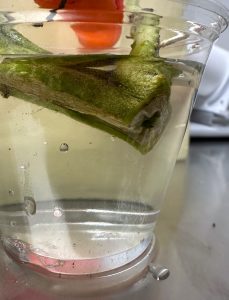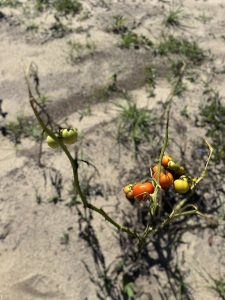The value of tomatoes produced in Florida in 2022 was $323,000,000 according to the USDA National Agricultural Statistics Survey and sometimes I feel like I’ll spend that much trying to get one perfect tomato in my garden. Nothing beats the taste of a fresh homegrown tomato, but unfortunately, they are susceptible to a wide host of diseases, insects, and even nematodes making them a challenge for even the most seasoned gardener.
Some of these pests can be tolerated without too much reduced yield, while others warrant removal of the plant to prevent further spread. Over the past couple of weeks, we have received a lot of calls about tomato plants that look normal and full of fruit one day then wilt despite plenty of available water. This symptom can be caused by a litany of ailments but when you also notice stem discoloration and perform the bacterial ooze test it is a pretty strong indicator that the cause may be bacterial wilt*.
The bacterial ooze test is simply taking a freshly cut stem of a symptomatic plant and placing it cut-side down into a glass of water (can be plastic but must be transparent) and watching for bacterial streaming. This will look like ribbons of goo coming out of the stem – that is not a technical term, but when you see it, you know it.
Bacterial wilt caused by Ralstonia solanacearum (Previously Pseudomonas solanacearum) affects over 200 species of plants. There are many strains including those affecting tomato, potato, and eggplant – all members of the nightshade family and commonly grown plants. If infected plant material is in the garden, it can spread to susceptible plants through wounds in roots or stems, nematode feeding, contaminated irrigation water, infected weeds, pruning equipment, and surface runoff. The pathogen can also remain viable in the soil for years, requiring well-planned crop rotation practices.
There is no cure and the best a gardener can do is spot it early and use good sanitation practices and crop rotation to minimize spread. For more information on this disease visit https://plantpath.ifas.ufl.edu/rsol/Trainingmodules/RalstoniaR3b2_Sptms_Module.html
Visit U-scout Tomato Diseases to view common tomato disease symptoms https://plantpath.ifas.ufl.edu/u-scout/tomato/index.html
*Please note that symptom observation and bacterial streaming tests do not constitute a definitive diagnosis and lab analysis is recommended for commercial producers.

Streams of bacterial ooze began about 5 minutes after placing tomato stem in water. Photo: J. McConnell, UFIFAS
- Thinking of Starting a Cut Flower Business? Don’t miss out on Cut Flower 101! - October 30, 2025
- 2025 Gardening in the Panhandle LIVE! Great Southeast Pollinator Census – Bee a Citizen Scientist! Wrap Up - September 18, 2025
- Will you Bee a Citizen Scientist? - August 15, 2025

